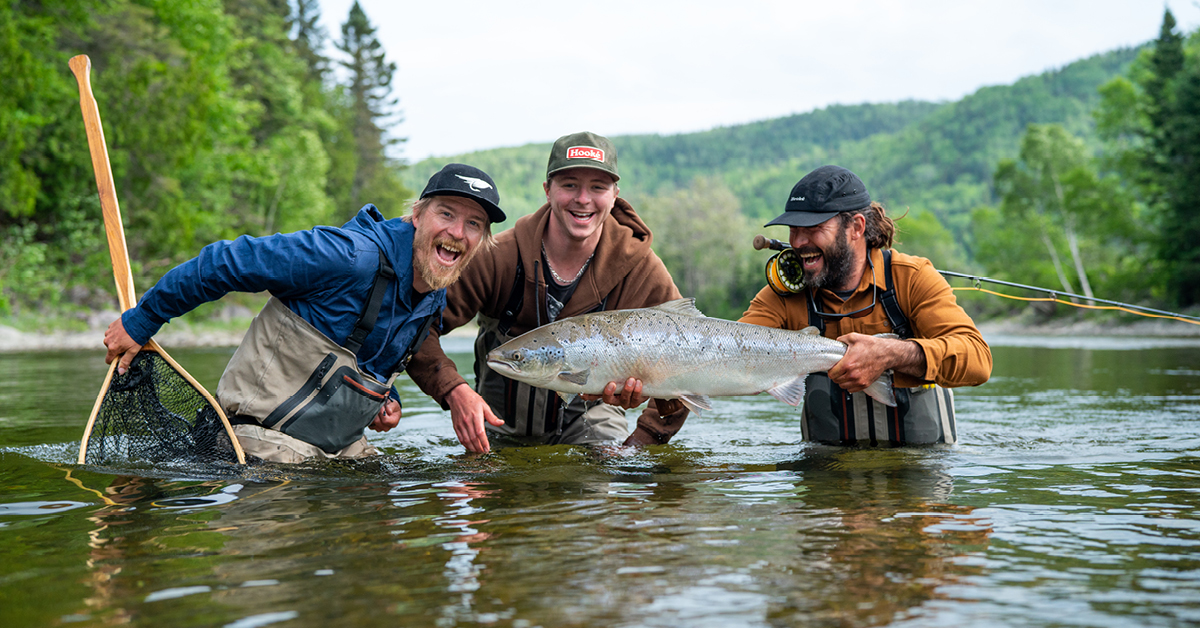CRAPPIE FISHING TECHNIQUES AND TIPS
Fishing | March 27, 2024
SAIL
May 21, 2021

Fly fishing has been growing in popularity over the course of the past few years. Imagine fishing with your feet in the water while leisurely casting out your line as Brad Pitt does in the 1992 Robert Redford film A River Runs Through It. We’re answering some of the most frequently-asked questions about the sport to help guide you as you discover more about this exciting outdoor sport.
Article produced in collaboration with Guillaume Morin, Hooké Brand Ambassador.
Just as traditional fishing, fly fishing can be done in a lake, a river, or even in the sea. The sport can be enjoyed in a watercraft, or from the shore for several different species of fish. It’s a technique that consists of loading your reel with line that’s heavy enough to propel an artificial fly that would be too light to propel otherwise. For this reason, fly fishermen and fisherwomen have to cast their line up into the air, so as to add momentum to it and propel their fly over distances that can reach up to 50 metres! When it comes to different casting techniques, they consist of loading the line with the help of a weighted lure. Because of these differences, and to allow you to enjoy your first experience to the max, it could be interesting to sign up for an introduction course to start off on the right foot.
A fly is an artificial lure composed of hair, feathers, and various other synthetic materials attached to a hook with the help of a string. They can imitate aquatic insects, flying insects, baitfish, or other small land and water animals. According to the law in the province of Quebec, the fly cannot include weights or rotating devices when it is used in areas reserved for fly fishing, such as salmon rivers.
It’s possible to fly fish with a minimum amount of gear: a rod, a reel, extra line, silk fly line, and a fly. However, to enjoy your experience to the fullest, waders can allow you to maximize your experience when fishing closer to the shore, to get closer to the action and the areas in which fish may be found. Also, various accessories will help you to get the most out of your trip: a fishing vest to carry all the necessary equipment, a scissor to help with fly-tying, pliers to unhook your fish, and a handheld net to help you with your catches. Finally, don’t forget about your safety. Wearing a hat or cap and polarized sunglasses will help you protect your eyes from UV rays – but also from flies! And, should you decide to venture out on the water, don’t forget your life jacket (PFD).
Fly fishing rods are classified according to the weight needed to load them. This weight is usually designated by a number from 0 to 12, although some manufacturers offer a wider range. The smaller the number, the less weight will be needed to load the rod and the fly will have to be smaller. To choose the right rod, it helps to consider the size of the flies you will be using, depending on the species of fish you’ve set your sights on. For example, when fishing for trout, which generally feed on aquatic insects in small rivers, you could select a 3 weight fly rod that will help you use small flies that imitate this type of small insect. If, though, you’ll be fishing for pike – a species that feeds mostly on smaller fish – you’ll have to consider a more powerful rod upon which you’ll be able to attach larger flies. A weight 9 rod would be a much better fit in this case. Take note that the weight number of the rod also corresponds to the line that will work best with it. Rods also vary in length and their use is determined by the environment in which you will be fishing. 6-ft or 7-ft rods (182 or 213 cm) are good for streams and small rivers flowing under dense vegetation, while 9 to 10-ft rods (274 or 304 cm) are more useful for lakes or in large rivers with clear banks.
The fly usually attaches to a monofilament or fluorocarbon leader whose length is usually the same as the length of the rod. These are spindle-shaped to provide the best possible presentation. Also, they have loops that allow them to be easily attached to the silk, the end of which often has a fused loop. Once the leader is installed on your line, you can tie your fly using a traditional fishing knot: the improved clinch knot. While there is a plethora of fishing knots that lend themselves to a variety of situations and techniques, the improved clinch knot will allow you to cover the vast majority of fishing situations.
Although fly fishing is an activity that may seem complex, the angler will be in constant learning mode and also learn with experience. The most important thing is having the right gear!
Shop – Fly Fishing